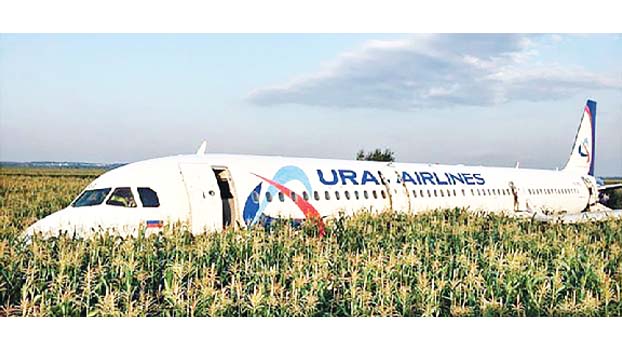Russia bird strike
Cool heads glide jet to safety

The Russian pilots who crash-landed a fuel-laden Airbus jet in a corn field, without any serious harm to the 233 people on board, are being hailed as heroes, report agencies.
The A321 was moments into its flight, after taking off from Moscow's Zhukovsky airport, when a flock of gulls got sucked into its engines, causing both to fail.
Russians are comparing the drama to "Miracle on the Hudson" - the bird strike that almost doomed an Airbus over New York in 2009, but ended happily when the pilot landed the jet safely in the Hudson River. It was a regular flight from Moscow to Simferopol, in Crimea, with 226 passengers on board, mostly going on holiday to the seaside.
The Ural Airlines plane weighed as much as 77 tonnes and pilot Damir Yusupov told reporters how narrowly the passengers and seven crew had escaped disaster.
The plane was climbing, accelerating, when first one engine, then the other, suddenly shut down.
When one engine failed they thought they could still turn back to the airport, Capt Yusupov said.
"When we saw that the second was also losing power, despite all of our efforts, the plane began losing height," he said.
"I changed my mind several times, because I was planning to gain height," he said. But Flightradar data shows that the A321 had only reached 243m (797ft).
"I planned to reach a certain height, hold it there, figure out the engine failure, make the correct decision, work it all out. But then it turned out there was really hardly any time."
Capt Yusupov and his co-pilot, Georgi Murzin, managed to stop the fuel supply to the engines and kept the jet level, gliding it down into the corn field, without lowering the undercarriage. With the wheels down, there is a risk of flying debris rupturing the plane's fuel tanks.
He said he had practised emergency landings on a flight simulator at Ural Airlines.
"I really don't feel like a hero," he said. "I did what I had to do, saved the plane, the passengers, the crew."
Yuri Sytnik, one of Russia's top pilots, told the daily Komsomolskaya Pravda: "The crew did everything by the book: shut down the engines... brought the plane down really smoothly, touched down first with the tail section, as required, killed the speed - that's a very tricky moment: you don't dip the nose, don't let an engine hit the ground."
Passengers were evacuated via escape slides and were told to get away from the plane quickly.
An 11-year-old boy, Vitya Babin, said: "One of the stewardesses said there was smoke coming from the plane and we immediately panicked. We ran after one of the men. He said follow me."
About 70 of the passengers got medical attention, as the landing was rough and they were bruised, but just one woman needed to stay in hospital.
Luckily, the high-standing maize crop acted like a cushion, and it was damp from rain, so sparks did not ignite it. In many other directions around Moscow the jet would have come up against a terrain of roads and buildings.
Russia's Vedomosti daily reports that in 2015 there were 411 bird strikes in Russia, and last year 1,021. But it is a daily hazard in aviation worldwide.
Data from the Civil Aviation Authority (CAA) shows there were 1,835 confirmed bird strikes in the UK in 2016, and 1,380 in 2012. As in Russia, the number has been steadily rising, suggesting a link with the growth in air traffic.
Gen Vladimir Popov, a military pilot quoted by Komsomolskaya Pravda, said Russian airports were assisted by bird-watching experts, but no counter-measures were wholly effective.
Airports use various methods: scarecrows, big shiny balls like those in discos, fire engines with loud sirens, bangs from bird-scaring projectiles and jets of water.
According to Gen Popov, August is a risky time, when young birds are taking wing, adventurous and full of energy.
The CAA says another deterrent is to keep airport grass well trimmed, reducing the habitats for wildlife that birds prey on. UK airports also have teams monitoring wildlife and analysing bird strikes.
How does this case differ from the Hudson River landing?
The New York drama was turned into a movie, "Sully: Miracle on the Hudson", and the Moscow flight could well be similarly immortalised.
Russian pilots interviewed by BBC Russian spoke of some significant differences, although both flights were almost doomed by bird strikes, and in both cases there was total engine failure.
Image copyright Getty Images Image caption The US Airways jet lying in the Hudson River in January 2009
All 155 people aboard the US plane were rescued by nearby boats and there were few serious injuries. The Moscow flight had a similar happy ending.
The Russian A321 pilots had less flying experience, whereas the US Airways pilot was aged 57, with 30 years' experience, and had also flown fighter jets.
The two Russians, however, had both graduated with top marks from a top civil aviation college. Capt Yusupov joined Ural Airlines in 2013, aged 33, after college; before then he had worked as a lawyer.
The Russians had less time to react. The US Airways jet had climbed to 975m before the bird strike - three times higher than the A321. In both cases, there were safe landing sites: a corn field and a fairly shallow stretch of the Hudson River.


